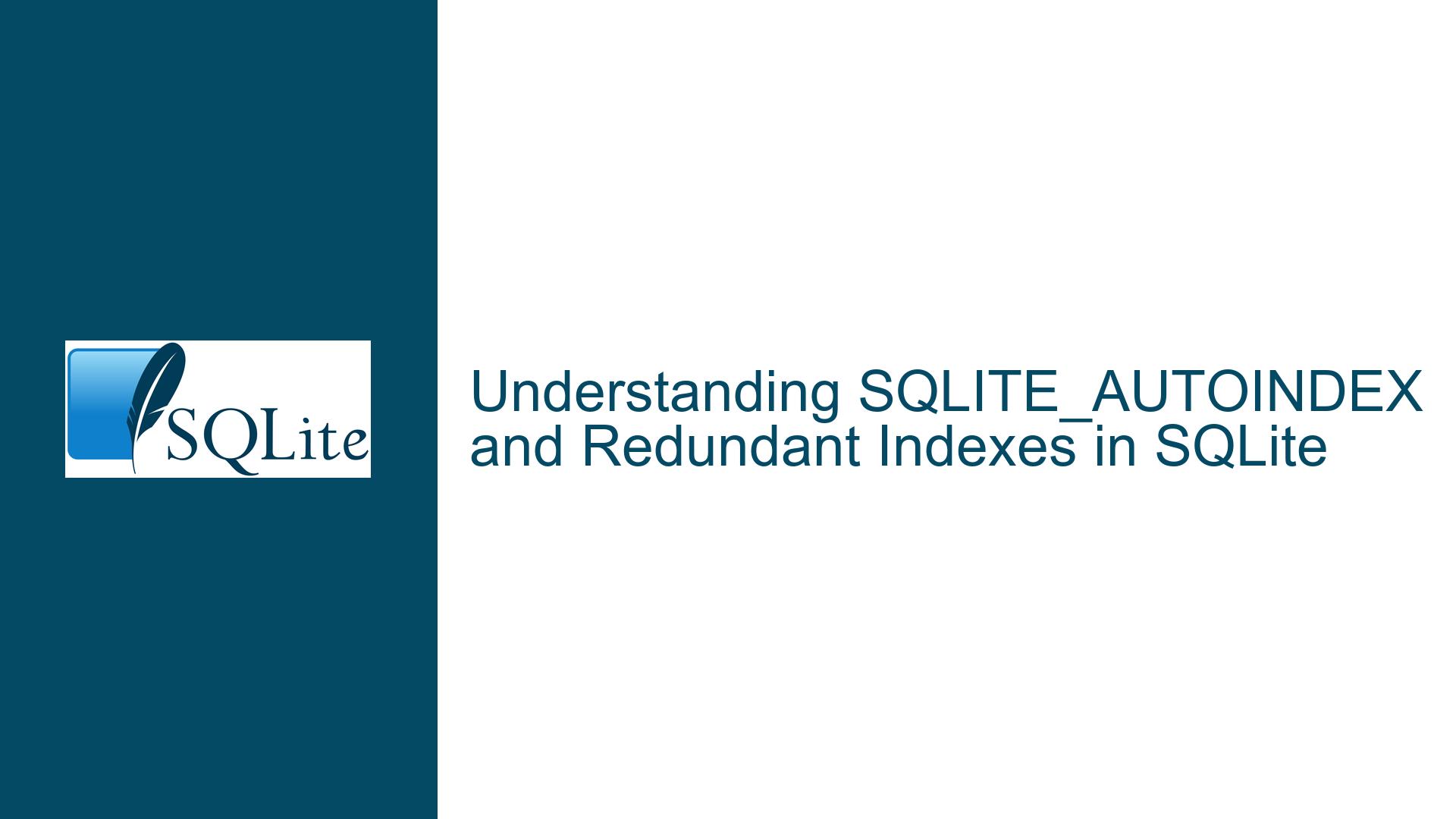SQLITE_AUTOINDEX and Redundant Indexes in SQLite
Issue Overview: SQLITE_AUTOINDEX and Primary Key Indexing
When working with SQLite, understanding how indexes are created and managed is crucial for optimizing database performance and storage. A common point of confusion arises when users encounter the SQLITE_AUTOINDEX in their database schema, particularly when it seems to duplicate the functionality of a primary key index. This issue is exemplified in the scenario where a table is created with a primary key and a unique constraint on another column, leading to the automatic creation of an index that appears redundant.
In the provided example, the table hash is defined with an id column as the primary key and a base32 column with a unique constraint. The primary key id inherently creates an index to enforce uniqueness and facilitate quick lookups. However, the unique constraint on base32 also necessitates an index to enforce uniqueness, which SQLite handles by automatically creating a SQLITE_AUTOINDEX. This auto-index is named SQLITE_AUTOINDEX_HASH_1 and serves the same purpose as an explicitly created unique index on base32.
The confusion stems from the assumption that the primary key index (id) and the table itself should suffice for all indexing needs. However, the unique constraint on base32 requires a separate index to ensure that no two rows have the same base32 value. This leads to the presence of both the primary key index and the SQLITE_AUTOINDEX, which can appear redundant but serve distinct purposes.
Possible Causes: Redundant Indexes and Misunderstandings in Schema Design
The presence of a SQLITE_AUTOINDEX alongside a primary key index can be attributed to several factors, primarily revolving around the enforcement of unique constraints and the implicit creation of indexes by SQLite.
1. Unique Constraints and Implicit Index Creation:
When a column is defined with a unique constraint, SQLite automatically creates an index to enforce that constraint. This is necessary because checking for uniqueness across a column requires efficient lookups, which are best facilitated by an index. In the case of the hash table, the unique constraint on base32 triggers the creation of SQLITE_AUTOINDEX_HASH_1. This auto-index ensures that no two rows in the table can have the same base32 value, thus maintaining data integrity.
2. Explicit Index Creation Leading to Redundancy:
In the provided schema, an explicit index hash_base32 is created on the base32 column after the table is defined. However, this explicit index is redundant because the unique constraint on base32 has already prompted SQLite to create an auto-index. The explicit index does not provide any additional functionality and only consumes extra storage space. This redundancy can be avoided by understanding that the unique constraint alone is sufficient to create the necessary index.
3. Misunderstanding of Primary Key Indexing:
The primary key id in the hash table inherently creates an index to enforce uniqueness and facilitate quick lookups. However, this index is specific to the id column and does not extend to other columns in the table. The unique constraint on base32 requires a separate index, which is why SQLITE_AUTOINDEX_HASH_1 is created. The misunderstanding arises from the assumption that the primary key index should cover all indexing needs, which is not the case when additional unique constraints are present.
Troubleshooting Steps, Solutions & Fixes: Optimizing Index Usage in SQLite
To address the issues of redundant indexes and optimize the schema design, the following steps and solutions can be implemented:
1. Removing Redundant Explicit Indexes:
The first step in optimizing the schema is to identify and remove any redundant indexes. In the case of the hash table, the explicit index hash_base32 is redundant because the unique constraint on base32 already creates an auto-index. Removing this explicit index will free up storage space and simplify the schema without affecting functionality. The revised schema should look like this:
CREATE TABLE hash (
id INTEGER PRIMARY KEY NOT NULL,
base32 TEXT UNIQUE NOT NULL
);
This schema ensures that the unique constraint on base32 is enforced by the auto-index SQLITE_AUTOINDEX_HASH_1, and no additional explicit index is needed.
2. Understanding the Role of Auto-Indexes:
It is important to understand that auto-indexes are created by SQLite to enforce unique constraints and facilitate efficient data retrieval. These auto-indexes are necessary for maintaining data integrity and should not be removed unless the unique constraint is also removed. In the case of the hash table, the auto-index SQLITE_AUTOINDEX_HASH_1 is essential for enforcing the uniqueness of base32 values and should be retained.
3. Evaluating the Need for Unique Constraints:
Before adding a unique constraint to a column, it is important to evaluate whether the constraint is necessary. Unique constraints are useful for ensuring data integrity, but they also come with the overhead of maintaining an index. If the unique constraint is not strictly necessary, it can be omitted to avoid the creation of an auto-index. However, in cases where data integrity is critical, the unique constraint and its associated auto-index are justified.
4. Monitoring Index Usage and Performance:
Regularly monitoring index usage and performance can help identify potential issues with redundant or underutilized indexes. SQLite provides tools such as sqlite3_analyzer to analyze the usage of indexes and tables. By reviewing the output of these tools, database administrators can identify indexes that are not being used and remove them to optimize storage and performance.
5. Schema Design Best Practices:
To avoid issues with redundant indexes and ensure optimal schema design, the following best practices should be followed:
- Use unique constraints only when necessary to enforce data integrity.
- Avoid creating explicit indexes that duplicate the functionality of auto-indexes.
- Regularly review and optimize the schema to remove redundant indexes and improve performance.
- Use tools like
sqlite3_analyzerto monitor index usage and identify potential issues.
By following these steps and best practices, database administrators can optimize their SQLite schemas, reduce storage overhead, and improve performance. Understanding the role of auto-indexes and the implications of unique constraints is key to achieving these goals.
In conclusion, the presence of a SQLITE_AUTOINDEX alongside a primary key index in SQLite is a result of the need to enforce unique constraints on columns other than the primary key. While this can lead to the appearance of redundant indexes, understanding the underlying mechanisms and following best practices can help optimize schema design and improve database performance. By removing redundant explicit indexes, evaluating the need for unique constraints, and regularly monitoring index usage, database administrators can ensure that their SQLite databases are both efficient and effective.






